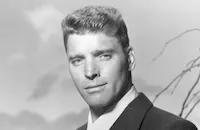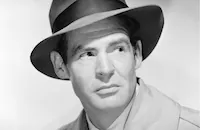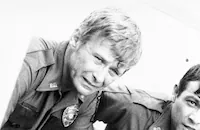Like most Americans who were over the age of ten on November 22, 1963, I remember where I was when I heard the jolting news that President John F. Kennedy had been killed. Also like most people, I've been hearing theories about the assassination ever since. Proposed by everyone from historians and journalists to amateur investigators and Oliver Stone, the theories challenge the Warren Commission's official conclusion that Lee Harvey Oswald was a freelance fanatic acting alone. On the contrary, the revisionists contend, a conspiracy - perhaps involving the CIA, the KGB, the Cubans, the mafia, Vice-President Lyndon B. Johnson, aliens from outer space, or some combination thereof - murdered the chief executive to serve their own ends.
Released two weeks before the tenth anniversary of the tragedy, David Miller's political thriller Executive Report tells the speculative tale of such a conspiracy. It begins with a text stating that after Johnson served his own years as president, he "expressed misgivings" about the lone-gunman conclusion and admitted his suspicion that multiple conspirators hatched and carried out the scheme. This makes Miller's 1973 film a direct precursor of Stone's 1991 epic JFK, which spins out a likeminded story in far more detail.
Executive Action makes a plausible case for its hypothesis that a right-wing conspiracy plotted the assassination to rescue the country from a Democratic administration with a liberal slant. The plausibility is boosted by the excellent actors who portray the ringleaders: Burt Lancaster plays James Farrington, a black-ops expert; Will Geer plays Harold Ferguson, a powerful oil tycoon; Ed Lauter plays the unnamed chief of the sniper team that actually commits the crime; and Robert Ryan plays Robert Foster, the leader of the enterprise. Ryan gives his character an especially persuasive blend of intelligence, malevolence, craftiness, and gravitas, and his performance is all the more impressive given his rapidly declining health at the time. He died of lung cancer four months before the film's premiere, but you'd never guess that from his steely presence on the screen.
The movie starts with a meeting at Foster's palatial home, where he and Farrington are angling for Ferguson's support by laying out their opposition to Kennedy's plans for the country. If this president stays in power, the schemers claim, he'll sign a treaty banning nuclear tests, pull American troops out of Vietnam, hand Asia to the communists, lead a "black revolution," and more. Racial paranoia runs especially high among the conspirators, who have morbid fears of "yellow, brown or black" hordes swarming from their "breeding grounds" until white privilege is just a memory.
The plotters might have been content to discredit Kennedy by besmirching his name, but they can't find a thing to use against him, so they're convinced that assassination is the only means of saving the American way. As for the workability of their scheme, Farrington observes that "in Europe, heads of state always die at the hands of conspirators," whereas American presidents are "always killed by madmen." Running through the relevant history, he points out that while some assassination attempts (Abraham Lincoln, James Garfield, William McKinley) have succeeded and others (Theodore Roosevelt, Franklin D. Roosevelt) have failed, each has been perpetrated by "a political fanatic willing to die." To pull off a successful assassination, he reasons, trained marksmen should do the shooting in a crowded setting - during a motorcade, for instance - and the political fanatic should be a stooge who's unaware of being manipulated. Consultants have already worked out the logistics, he adds, and shooters are now rehearsing for the event.
Ferguson remains skeptical. The president isn't as far left as all that, he says, and the current crisis should be solvable by something short of assassination. Although his own "intelligence men" have done dirty work on his behalf, he continues, such deeds are "tolerable only if they're necessary and permissible only if they work." So he recommends patience for the time being. Before long, however, Kennedy's liberal policies become too much for him to bear. When a newscast convinces him that the president really means to wind down the Vietnam conflict, he calls Foster and signals his full cooperation.
The most striking element of Executive Action is the documentary material woven into its fictional framework. News reports show Martin Luther King, Jr. giving his "I have a dream" speech, Edward Teller testifying against the test-ban treaty, Kennedy announcing policies, Air Force One landing in Dallas, the presidential motorcade entering Dealey Plaza, and so on, and the legendary Zapruder film shows JFK dying when the bullets strike. The real Lee Harvey Oswald appears in photos and news footage, and actor James Mac Coll plays an Oswald double hired by the conspirators to cook up evidence of his volatility and weirdness. The fictional and factual materials are intercut as smoothly as can reasonably be expected - film editor George Grenville deserves high marks - and cinematographer Robert Steadman gives the main body of the film a moderately realistic look that keeps the archival footage from seeming too intrusive. The only ill-fitting moments come when nightclub boss Jack Ruby (Oscar Oncidi) talks with an employee (Deanna Darrin, the film's only woman) two days before shooting Oswald in the Dallas police headquarters; unlike the rest of the movie, this is a strangely amateurish scene.
Plots against politicians can be launched by radicals from either end of the ideological spectrum, but the villains of Executive Action are explicitly identified as ultraconservatives, and it's fair to say that the film's creative team was a family gathering of Hollywood liberals. Ryan supported civil-rights and pacifist causes throughout his career, even when the characters he played tilted strongly in other directions. Lancaster had similar views, and Geer was blacklisted for refusing to testify before the House Committee on Un-American Activities during the McCarthy era. The screenplay was penned by Dalton Trumbo, a member of the Hollywood Ten whose resistance of McCarthyism led to blacklisting and prison time, and the original scenario was co-written by Mark Lane, author of the 1966 bestseller Rush to Judgment, which calls the Warren report into serious question. The filmmakers' liberal perspective is plain to see, and that may partly explain why unfavorable press drove the picture out of many theaters within days of its debut.
Seen today, Executive Action has solid entertainment value and considerable historical interest, whether or not you like its ideas or find the story believable. A number of films with similar themes have followed it over the years, most of which - Alan J. Pakula's The Parallax View (1974), William Richert's Winter Kills (1979), Jonathan Kaplan's Love Field (1992), Wolfgang Petersen's In the Line of Fire (1993) - allude to Kennedy's assassination indirectly rather than head-on. Many questions still linger about November 22, 1963, and it's fascinating to watch actors as gifted as Ryan, Lancaster, and the perennially underappreciated Geer grapple smartly and sincerely with the subject.
Director: David Miller
Producer: Edward Lewis
Screenplay: Dalton Trumbo; story by Mark Lane and Donald Freed
Cinematographer: Robert Steadman
Film Editing: George Grenville
Art Direction: Kirk Axtell
Music: Randy Edelman
With: Burt Lancaster (James Farrington), Robert Ryan I(Robert Foster), Will Geer (Harold Ferguson), Gilbert Green (Paulitz), John Anderson (Halliday), (Paul Carr (Chris), Colby Chester (Tim), Ed Lauter (operations chief), Walter Brooke (Smythe), Lloyd Gough (Charlie McCadden), James Mac Coll (Lee Harvey Oswald lookalike), Oscar Oncidi (Jack Ruby), Deanna Darrin (stripper)
Color & BW-91m.
by David Sterritt
Executive Action

Brief Synopsis
Rogue intelligence agents, politicians, greedy capitalists, and assassins plot and carry out an assassination.
Cast & Crew
Read More
David Miller
Director
Burt Lancaster
Robert Ryan
Paul Carr
Will Geer
Lloyd Gough
Film Details
MPAA Rating
Genre
Crime
Drama
Political
Thriller
Release Date
Jan
1973
Premiere Information
not available
Country
United States
Technical Specs
Duration
1h 31m
Sound
Mono
Color
Color
Synopsis
A dramatic hypothesis constructed from the conspiracy theories advanced by persistent Kennedy assassination investigator Mark Lane, in turn based on evidence the Warren Commission refused to hear.
Director

David Miller
Director
Cast

Burt Lancaster

Robert Ryan

Paul Carr

Will Geer

Lloyd Gough
Gilbert Green
John Anderson
Ed Lauter
Lee Delano
William Watson
Paul Sorenson
Walter Brooke
John Brascia
James Maccoll
Deanna Darrin
Joaquin Martinez
Sandy Ward
Hunter Von Leer
Robert Karnes
Oscar Oncidi
Dick Miller

Sidney Clute
Colby Chester
Rick Hurst
Richard Bull
Crew
Kirk Axtell
Art Director
Dan Bessie
Coproducer
Bruce Bisenz
Sound
Randy Edelman
Music
Donald Freed
From Story
George Grenville
Editor
Gary Horowitz
Coproducer
Steve Jaffe
Consultant
Mark Lane
From Story
Irving Lerner
Editor
Edward Lewis
Producer
Robert Steadman
Cinematographer
Dalton Trumbo
Screenplay
Videos
Movie Clip




Film Details
MPAA Rating
Genre
Crime
Drama
Political
Thriller
Release Date
Jan
1973
Premiere Information
not available
Country
United States
Technical Specs
Duration
1h 31m
Sound
Mono
Color
Color
Articles
Executive Action

Executive Action
Like most Americans who were over the age of ten on November 22, 1963, I remember where I was when I heard the jolting news that President John F. Kennedy had been killed. Also like most people, I've been hearing theories about the assassination ever since. Proposed by everyone from historians and journalists to amateur investigators and Oliver Stone, the theories challenge the Warren Commission's official conclusion that Lee Harvey Oswald was a freelance fanatic acting alone. On the contrary, the revisionists contend, a conspiracy - perhaps involving the CIA, the KGB, the Cubans, the mafia, Vice-President Lyndon B. Johnson, aliens from outer space, or some combination thereof - murdered the chief executive to serve their own ends.
Released two weeks before the tenth anniversary of the tragedy, David Miller's political thriller Executive Report tells the speculative tale of such a conspiracy. It begins with a text stating that after Johnson served his own years as president, he "expressed misgivings" about the lone-gunman conclusion and admitted his suspicion that multiple conspirators hatched and carried out the scheme. This makes Miller's 1973 film a direct precursor of Stone's 1991 epic JFK, which spins out a likeminded story in far more detail.
Executive Action makes a plausible case for its hypothesis that a right-wing conspiracy plotted the assassination to rescue the country from a Democratic administration with a liberal slant. The plausibility is boosted by the excellent actors who portray the ringleaders: Burt Lancaster plays James Farrington, a black-ops expert; Will Geer plays Harold Ferguson, a powerful oil tycoon; Ed Lauter plays the unnamed chief of the sniper team that actually commits the crime; and Robert Ryan plays Robert Foster, the leader of the enterprise. Ryan gives his character an especially persuasive blend of intelligence, malevolence, craftiness, and gravitas, and his performance is all the more impressive given his rapidly declining health at the time. He died of lung cancer four months before the film's premiere, but you'd never guess that from his steely presence on the screen.
The movie starts with a meeting at Foster's palatial home, where he and Farrington are angling for Ferguson's support by laying out their opposition to Kennedy's plans for the country. If this president stays in power, the schemers claim, he'll sign a treaty banning nuclear tests, pull American troops out of Vietnam, hand Asia to the communists, lead a "black revolution," and more. Racial paranoia runs especially high among the conspirators, who have morbid fears of "yellow, brown or black" hordes swarming from their "breeding grounds" until white privilege is just a memory.
The plotters might have been content to discredit Kennedy by besmirching his name, but they can't find a thing to use against him, so they're convinced that assassination is the only means of saving the American way. As for the workability of their scheme, Farrington observes that "in Europe, heads of state always die at the hands of conspirators," whereas American presidents are "always killed by madmen." Running through the relevant history, he points out that while some assassination attempts (Abraham Lincoln, James Garfield, William McKinley) have succeeded and others (Theodore Roosevelt, Franklin D. Roosevelt) have failed, each has been perpetrated by "a political fanatic willing to die." To pull off a successful assassination, he reasons, trained marksmen should do the shooting in a crowded setting - during a motorcade, for instance - and the political fanatic should be a stooge who's unaware of being manipulated. Consultants have already worked out the logistics, he adds, and shooters are now rehearsing for the event.
Ferguson remains skeptical. The president isn't as far left as all that, he says, and the current crisis should be solvable by something short of assassination. Although his own "intelligence men" have done dirty work on his behalf, he continues, such deeds are "tolerable only if they're necessary and permissible only if they work." So he recommends patience for the time being. Before long, however, Kennedy's liberal policies become too much for him to bear. When a newscast convinces him that the president really means to wind down the Vietnam conflict, he calls Foster and signals his full cooperation.
The most striking element of Executive Action is the documentary material woven into its fictional framework. News reports show Martin Luther King, Jr. giving his "I have a dream" speech, Edward Teller testifying against the test-ban treaty, Kennedy announcing policies, Air Force One landing in Dallas, the presidential motorcade entering Dealey Plaza, and so on, and the legendary Zapruder film shows JFK dying when the bullets strike. The real Lee Harvey Oswald appears in photos and news footage, and actor James Mac Coll plays an Oswald double hired by the conspirators to cook up evidence of his volatility and weirdness. The fictional and factual materials are intercut as smoothly as can reasonably be expected - film editor George Grenville deserves high marks - and cinematographer Robert Steadman gives the main body of the film a moderately realistic look that keeps the archival footage from seeming too intrusive. The only ill-fitting moments come when nightclub boss Jack Ruby (Oscar Oncidi) talks with an employee (Deanna Darrin, the film's only woman) two days before shooting Oswald in the Dallas police headquarters; unlike the rest of the movie, this is a strangely amateurish scene.
Plots against politicians can be launched by radicals from either end of the ideological spectrum, but the villains of Executive Action are explicitly identified as ultraconservatives, and it's fair to say that the film's creative team was a family gathering of Hollywood liberals. Ryan supported civil-rights and pacifist causes throughout his career, even when the characters he played tilted strongly in other directions. Lancaster had similar views, and Geer was blacklisted for refusing to testify before the House Committee on Un-American Activities during the McCarthy era. The screenplay was penned by Dalton Trumbo, a member of the Hollywood Ten whose resistance of McCarthyism led to blacklisting and prison time, and the original scenario was co-written by Mark Lane, author of the 1966 bestseller Rush to Judgment, which calls the Warren report into serious question. The filmmakers' liberal perspective is plain to see, and that may partly explain why unfavorable press drove the picture out of many theaters within days of its debut.
Seen today, Executive Action has solid entertainment value and considerable historical interest, whether or not you like its ideas or find the story believable. A number of films with similar themes have followed it over the years, most of which - Alan J. Pakula's The Parallax View (1974), William Richert's Winter Kills (1979), Jonathan Kaplan's Love Field (1992), Wolfgang Petersen's In the Line of Fire (1993) - allude to Kennedy's assassination indirectly rather than head-on. Many questions still linger about November 22, 1963, and it's fascinating to watch actors as gifted as Ryan, Lancaster, and the perennially underappreciated Geer grapple smartly and sincerely with the subject.
Director: David Miller
Producer: Edward Lewis
Screenplay: Dalton Trumbo; story by Mark Lane and Donald Freed
Cinematographer: Robert Steadman
Film Editing: George Grenville
Art Direction: Kirk Axtell
Music: Randy Edelman
With: Burt Lancaster (James Farrington), Robert Ryan I(Robert Foster), Will Geer (Harold Ferguson), Gilbert Green (Paulitz), John Anderson (Halliday), (Paul Carr (Chris), Colby Chester (Tim), Ed Lauter (operations chief), Walter Brooke (Smythe), Lloyd Gough (Charlie McCadden), James Mac Coll (Lee Harvey Oswald lookalike), Oscar Oncidi (Jack Ruby), Deanna Darrin (stripper)
Color & BW-91m.
by David Sterritt
Quotes
Yeah, I got his rifle. It's a 6.5 millimeter Italian Carcano. It shoots high and to the left, and the bolt sticks. Christ, the Italians quit makin' these 25 years ago! They called it "The rifle that never hurt anyone... on purpose!"- Chris
Oh, it will all be over soon. Then all we'll have left to call our own is death---that barren mound of earth that serves as paste and mortar to cover our bones. For God's sake, let us gather 'round tonight and tell tales of great kings!- Foster
Trivia
Miscellaneous Notes
Released in United States Winter January 1, 1973
Released in United States Winter January 1, 1973













